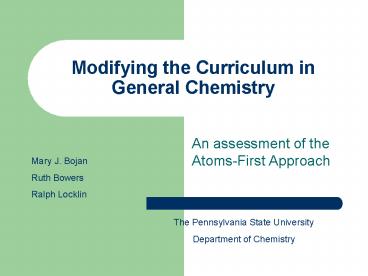Modifying the Curriculum in General Chemistry - PowerPoint PPT Presentation
Title:
Modifying the Curriculum in General Chemistry
Description:
... to General Chemistry vs. Atoms First. TRADITIONAL. Nomenclature ... Nomenclature. Structure/properties of molecules. Properties of gases, liquids , solids ... – PowerPoint PPT presentation
Number of Views:42
Avg rating:3.0/5.0
Title: Modifying the Curriculum in General Chemistry
1
Modifying the Curriculum in General Chemistry
- An assessment of the Atoms-First Approach
Mary J. Bojan Ruth Bowers Ralph Locklin
The Pennsylvania State University Department of
Chemistry
2
Traditional Approach to General Chemistry vs.
Atoms First
- TRADITIONAL
- Nomenclature
- Stoichiometry
- Aqueous reactions
- Energy (Enthalpy) in reactions
- Structure/properties of atoms
- Structure/properties of molecules
- Properties of gases, liquids , solids
- Properties of aqueous solutions
- Kinetics
- Equilibrium
- ATOMS FIRST
- Structure/properties of atoms
- Nomenclature
- Structure/properties of molecules
- Properties of gases, liquids , solids
- Properties of aqueous solutions
- Stoichiometry
- Aqueous reactions
- Energy (Enthalpy) in reactions
- Kinetics
- Equilibrium
3
Rationale build from the basics
- Start with basics
- Structure/properties of atoms
- Structure and properties of molecules
- Emphasize structure effects function
- Interaction of energy with matter incorporated
throughout - Photon interacting with matter
- Electrostatic forces
- Intermolecular forces
- Bond energies
- Reactions introduced AFTER structure and
properties are understood - Finally thermodynamics (equilibrium) and
kinetics can be understood.
4
Assessment
- Compare results from two similar classes
- Fall 2004 (traditional sequence)
- Fall 2005 (atoms first sequence)
- 4 of 5 instructors are the same
- Deliver Content
- Write exams
- Overall content for both courses was same (no
material was added or deleted) - Exams given in evening at same time of day
- Format of exams (MC) and of questions per exam
is same - Student Demographics are the same
5
Exam Analysis
- Compare Final Exam Results
- Fall 2004 (traditional sequence)
- Fall 2005 (atoms first sequence)
- Comprehensive Final
- 72 mean for both semesters
- Marker Questions
- Similar questions from exams encountered at
different times in the semester - Test Progression
- Same concepts encountered in later exams during
the same semester. - Topic Groupings
- Total number of exam questions in a broader topic
area
6
Assessing this approachQualitatively
- Survey of students
- 194 students responded to survey
- 72 were first semester freshman
- 5 (10 students) had taken course with old
sequence - Survey Questions
- Sequence of topics
- Difficulty of material in relationship to
sequence - Role of textbook in determining sequence
7
Marker Questions
Topic 2004 2005
Equilibrium Final 80 Final 79
Net Ionic Equations Final 64 Final 73
Gas Laws Exam 3 81 Exam 2 80
Atom/ion Structure Exam 1 88 Exam 1 95
Bohr Model Exam 2 76 Exam 1 68
Quantum Numbers Exam 2 77 Exam 1 78
Final Exam 72 72
8
Thermodynamics
9
Aqueous
10
Test Progression Colligative Properties
Atoms first Approach
11
Test ProgressionIntermolecular forces
Intermolecular forces and properties of
liquids 2004 3 questions on Final exam 2005
10 questions on 3 exams
12
Survey results
- Survey Questions 3 in each area
- Sequence of topics
- Difficulty of material in relationship to
sequence - Role of textbook in determining sequence
- Scale
- Strongly agree
- Agree
- Neither
- Disagree
- Strongly disagree
13
Sequence of Topics
Knowledge of atomic structure helped with
conceptual understanding of material.
14
Difficulty of material in relationship to
sequence
15
Role of Textbook in determining sequence
16
Summary survey
- Sequence of Topics
- 65 agree/strongly agree that topic sequence is
logical (only 19 disagree) - 62 agree/strongly agree that knowledge of atomic
structure helped with conceptual understanding
(only 15 disagree) - Sequence was very different 39 agree, 29
disagree, 32 neither - Difficulty of material
- Only 26 agreed that the atoms first sequence
required extra help early. (49 disagree, 25
neither) - 56 agreed that material was easier to understand
since reactions came up later. Only 20 disagree. - Only 23 agreed that the concepts were more
difficult because the sequence was different form
the text book (59 disagreed)
17
Summary Survey
- Role of Textbook in determining sequence
- 32 claimed they had difficulty reading text
because it had not been covered in lecture. - 59 felt it was important for the textbook to
match the lecture (23 disagreed with this) - 40 agreed that the atoms first sequence made
more sense than the textbook sequence. Another
39 were neutral.
18
Interview and survey
- Found the sequence to be logical
- Did not notice difference between atoms first and
their previous courses - Did not mind covering material in different
sequence from text syllabus provided a
sufficient guide - Conclusion the new sequence did not drastically
improve student perception of learning and
understanding, but it did not hurt!
19
Unforeseen Consequences
- Mismatch between lecture and lab
- Lab focuses on reactions
- Students encounter material in lab before it is
covered in lecture
20
Conclusions
- Faculty perspective atoms first approach is more
logical approach - Student performance was not improved but it was
not hurt - Detailed syllabus was effective guide when
material was covered in different sequence from
text. - Problem integration of Lab and lecture
21
Atomic structure

